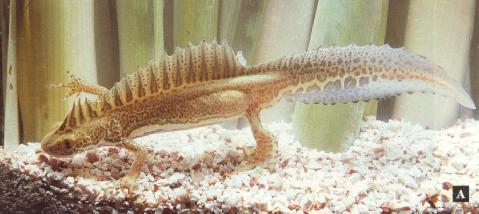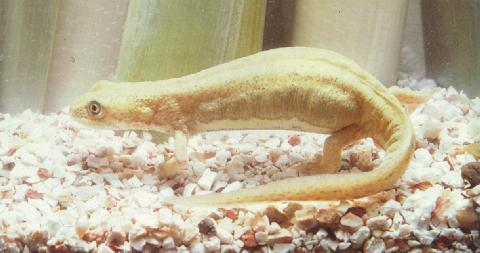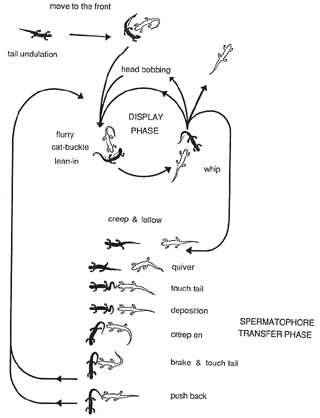
TRITURUS VITTATUS (=OMMATOTRITON VITTATUS, OMMATOTRITON OPHRYTICUS) : THE BANDED NEWT

Male Triturus vittatus. Photo by R. Griffiths.

Female Triturus vittatus. Photo by R. Griffiths.


Mating behaviour: male shown in black, female in white. From Raxworthy (1989).
DESCRIPTION
The banded newt occurs in two distinct areas in the south-east of the European area. This is a large and unmistakeable newt, growing to around 16 cm, the male being larger than the female. Both sexes are olive-green, brown or yellow, with a dark-edged white band running from the cheeks to the base of the tail. The belly is yellow or orange, and may have some darker markings. Females are rather drab, but males exhibit fine dark mottling on the flanks and spotting on the tail. The white band also continues onto the tail in males. Breeding males have an extremely high (up to 4.5 cm), deeply serrated crest, with light and dark stripes. On the tail, the crest is less serrated, but is still very broad.
SUBSPECIES
Triturus v. vittatus
The nominate form is found along the eastern edge of the
Mediterranean Sea, from Turkey to Israel.
Triturus v. ophryticus
This subspecies occurs in the Caucasus, to the east and south of
the Black Sea.
Another subspecies, T. v. cilicensis, is somewhat controversial- some authorities believe it is not valid. Newts from the far south-east of the species' range in Turkey, to the west of the Amanos mountains, have previously been identified as this subspecies. Individuals from this area have been described as having a greater number of spikes in the male's crest (14 or more, compared to 14 or less in T. v. vittatus), and having interrupted, rather than solid, black bands bordering the white band along the flanks, in both sexes.
An isolated record of this species (Franzen, 2000), further to the east in Turkey, has been provisionally attributed to this subspecies.Litvinchuk et al. (2004) have proposed that these newts should be moved to the genus Ommatotriton, and that this genus should contain two species, Ommatotriton vittatus for the Southern populations, and Ommatotriton ophryticus for the Nothern populations. A new subspecies, O. ophryticus nesterovi, is also proposed for the Western part of the distribution of O. ophryticus.
REFERENCES
Franzen, M., 2000. A distribution record of the Banded Newt, Triturus vittatus, from the Mesopotamian Plain, southeastern Turkey. The Herpetological Bulletin, 74: 26-28.
Litvinchuk, S. N., Zuiderwijk, A., Borkin, L. J., & Rosanov, J. M., 2004. Taxonomic status of Triturus vittatus (Amphibia: Salamandridae) in western Turkey: trunk vertebrae count, genome size and allozyme data. Amphibia-Reptilia 3:305-323.
Olgun, K., Tok, V., Arntzen, J. W., & Turkozan, O., 1997. The taxonomic status of the Banded Newt (Triturus vittatus) in southern Turkey. The Herpetological Journal, 7: 169-171.
Raxworthy, C. J., 1989. Courtship,
Fighting and Sexual Dimorphism of the Banded Newt, Triturus
vittatus ophryticus. Ethology 81:
148-170.
